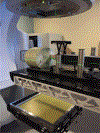Clinical translation of a new flat-panel detector for beam's-eye-view imaging
- PMID: 33284786
- PMCID: PMC9142212
- DOI: 10.1088/1361-6560/abb571
Clinical translation of a new flat-panel detector for beam's-eye-view imaging
Abstract
Electronic portal imaging devices (EPIDs) lend themselves to beams-eye view clinical applications, such as tumor tracking, but are limited by low contrast and detective quantum efficiency (DQE). We characterize a novel EPID prototype consisting of multiple layers and investigate its suitability for use under clinical conditions. A prototype multi-layer imager (MLI) was constructed utilizing four conventional EPID layers, each consisting of a copper plate, a Gd2O2S:Tb phosphor scintillator, and an amorphous silicon flat panel array detector. We measured the detector's response to a 6 MV photon beam with regards to modulation transfer function, noise power spectrum, DQE, contrast-to-noise ratio (CNR), signal-to-noise ratio (SNR), and the linearity of the detector's response to dose. Additionally, we compared MLI performance to the single top layer of the MLI and the standard Varian AS-1200 detector. Pre-clinical imaging was done on an anthropomorphic phantom, and the detector's CNR, SNR and spatial resolution were assessed in a clinical environment. Images obtained from spine and liver patient treatment deliveries were analyzed to verify CNR and SNR improvements. The MLI has a DQE(0) of 9.7%, about 5.7 times the reference AS-1200 detector. Improved noise performance largely drives the increase. CNR and SNR of clinical images improved three-fold compared to reference. A novel MLI was characterized and prepared for clinical translation. The MLI substantially improved DQE and CNR performance while maintaining the same resolution. Pre-clinical tests on an anthropomorphic phantom demonstrated improved performance as predicted theoretically. Preliminary patient data were analyzed, confirming improved CNR and SNR. Clinical applications are anticipated to include more accurate soft tissue tracking.
Figures










References
-
- Antonuk LE. Electronic portal imaging devices: a review and historical perspective of contemporary technologies and research. Phys Med Biol. 2002; 47(6):R31–R65. - PubMed
-
- Antonuk L, Yorkston J, Boudry J, Longo M, Jimenez J, Street R. Development of hydrogenated amorphous silicon sensors for high energy photon radiotherapy imaging, IEEE Transactions on Nuclear Science. 1990; 37(2):165–170.
-
- Bakhtiari M, Kumaraswamy L, Bailey DW, de Boer S, Malhotra HK, Podgorsak MB. Using an EPID for patient-specific VMAT quality assurance. Med Phys. 2011; 38: 1366–1373. - PubMed
-
- El-Mohri Y, Jee KW, Antonuk LE, Maolinbay M, Zhao Q. Determination of the detective quantum efficiency of a prototype, megavoltage indirect detection, active matrix flat-panel imager. Med Phys. 2001; 28(12):2538–2550. - PubMed
Publication types
MeSH terms
Grants and funding
LinkOut - more resources
Full Text Sources
Medical
Research Materials
